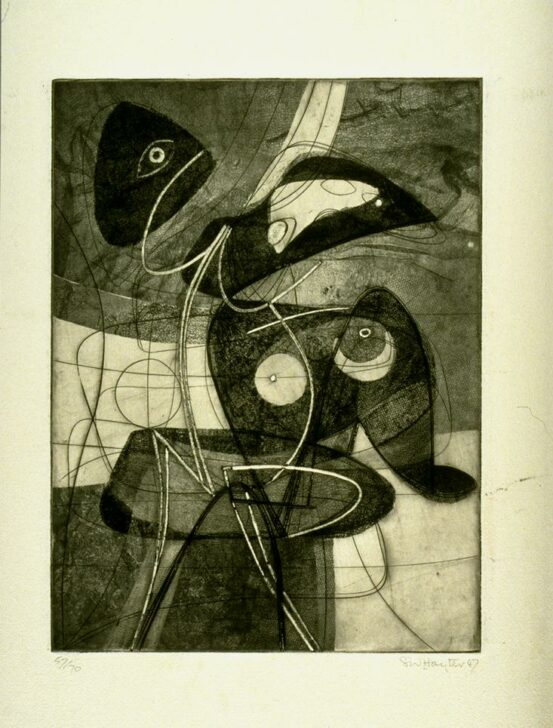Personnage Virtualle
S. W. Hayter; Brunidor Editions; Atelier 17

Description
In his etchings, William Hayter has uncovered the secret channels one must follow if one is to arrive at humanizing the machine . . . In Hayter’s work what might be recognized as the ellipse traced by an airplane, a bird or a fish remains actually always the handwriting of an artist who handles his material with the care and ability of the most dextrous goldsmith.
All of the etchings in The Brunidor Portfolio were printed at Hayter’s Atelier 17 in New York. Hayter’s attention to detail and continuing innovations in printmaking procedures allowed the artists represented in The Brunidor Portfolio to capture the great array of effects seen in the prints.
Strikingly similar in effect to the nudes in Brassaï’s Transmutations portfolio on the opposite wall of the gallery, this engraving by Hayter transforms and dissects the female form to create something new.
In his etchings, William Hayter has uncovered the secret channels one must follow if one is to arrive at humanizing the machine . . . In Hayter’s work what might be recognized as the ellipse traced by an airplane, a bird or a fish remains actually always the handwriting of an artist who handles his material with the care and ability of the most dextrous goldsmith.
All of the etchings in The Brunidor Portfolio were printed at Hayter’s Atelier 17 in New York. Hayter’s attention to detail and continuing innovations in printmaking procedures allowed the artists represented in The Brunidor Portfolio to capture the great array of effects seen in the prints.
Strikingly similar in effect to the nudes in Brassaï’s Transmutations portfolio on the opposite wall of the gallery, this engraving by Hayter transforms and dissects the female form to create something new.
Label copy from exhibition "Dreamscapes: The Surrealist Impulse," August 22 - October 25, 1998
Subject Matter:
This print is part of a portfolio published by Brunidor Editions, New York, the portfolio's namesake, at the request of art critic Nicholas Calas. The portfolio includes seven prints from a number of prominent Surrealist artists, including: Max Ernst, Joan Miró, Wifredo Lam, Roberto Matta, Kurt Seligmann, and Yves Tanguy. Calas’ introduction to the portfolio turned on the age-old controversy between line and color, in which line or form is seen as relating to thought, while color or light is considered pertinent to emotion. Calas describes not only what these artists "see" with their imaginations, but also what, as a critic, he "sees" as he interprets the inherent meanings of these prints.
Hayter's contribution, plate six of seven, creates an abstract image of a person, broken up into various lines and shades. Hayter was introduced to Surrealism in 1929 and used the style to make works reacting to the rise of Fascism in Europe. When he produced this print, he was in exile in New York during WWII, where he ran the group "Atelier 17," which printed this portfolio. Hayter's innovative use of the print media can be seen in this work with his rich combination of techniques. Two years later, Hayter published his first book on printmaking New Ways of Gravure (1949).
Physical Description:
This abstract print has a series of overlapping lines, emphasized by shading. Created in a variety of techniques, the shading creates an incoherent system of depth, as well as a variety of textures. At the top left, there is an anthropomorphic face. The print is sighed and dated (l.r.) "S W Hayter 47" and numbered (l.l.) "57/70" in pencil.
Usage Rights:
If you are interested in using an image for a publication, please visit https://umma.umich.edu/request-image/ for more information and to fill out the online Image Rights and Reproductions Request Form.